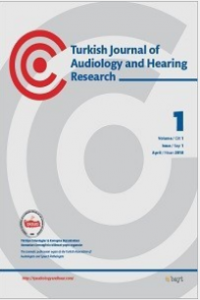TONE-BURST UYARILI İŞİTSEL BEYİN SAPI YANITLARI İLE İŞİTSEL UYARILMIŞ DURGUN DURUM YANITLARININ KARŞILAŞTIRILMASI
Amaç: Bu çalışmada, normal işiten bireylerde tone-burst İşitsel Beyin Sapı (ABR) ile İşitsel Uyarılmış Durgun Durum (ASSR) sonuçlarını karşılaştırdık
Gereç ve Yöntemler: Bu çalışma, İstanbul Medipol Üniversitesi’nde okuyan 18-25 yaş arası normal işitmeye sahip 14 kadın ve 16 erkek olmak üzere 30 birey üzerinde yapılmıştır. Çalışmaya katılan kişilere akustik immitansmetri ve saf ses odyometrisi yapılmış, daha sonra tone-burst ABR yapılarak 500-4000 Hz’ arası frekans işitme eşikleri tespit edilmiştir ve ASSR uygulanmıştır.
Bulgular: Tone-burst ABR ve ASSR eşikleri arasında yüksek frekanslarda iyi bir korelasyon gözlendi. Spearman korelasyon katsayıları 4000 Hz sağ ve sol kulak için sırasıyla 0.125; 0.70, 2000 Hz sağ ve sol kulak için sırasıyla 0.92; 0.629 olarak bulundu (p>0.05). 1000 ve 500 Hz’ler de her iki kulak için Spearman korelasyon katsayıları 0.0 olarak bulundu (p<0,05). Test olasılık değeri p<0,05 olduğundan dolayı 500 ve 1000 Hz’ lerde iki test arası istatistiksel olarak anlamlı fark gözlenmiştir.
Sonuç: Tone-burst ABR testinde elde edilen cevapların yorumlanması ve V. dalganın tespiti klinisyenin değerlendirmesine dayanmaktadır. ASSR testinde ise, elde edilen cevapların değerlendirilmesi subjektif yorumlama olmadan yapılmaktadır. Yapmış olduğumuz çalışmada ASSR eşiklerinin tone burst ABR eşikleri ile bir birine yakın sonuçlar vermesi ve test süresinin kısa olmasından dolayı, ASSR testinin işitme eşiklerini belirlemede özellikle yüksek frekans bölgesinde güvenilir olarak kullanılabilecek bir test olduğunu göstermektedir.
A Comparison of the Results Measured by Auditory Steady State Responses and Using Frequency-Specific Evoked Auditory Brainstem Response
Objective: In this study, we aimed to compare the results of tone-burst ABR with ASSR in normal-hearing individuals.
Material and Methods: Thirty (fourteen females and sixteen males) normal-hearing students between the age of 18 and 25 from Istanbul Medipol University participated in this study. The acoustic immitansmetry and pure voice audiometry tests were performed on the participants. Then, frequency hearing thresholds between 500-4000 Hz of participants were identified by conducting a tone-burst ABR, and ASSR was carried out.
Results: The results indicated that there was no statisticaly significant difference between the Tone-burst ABR and ASSR in the higher thresholds (4000 to 2000 Hz); however when we look at the lower thresholds (1000 to 500 Hz) there was a statistically significant difference between the tone-burst ABR and ASSR. The Spearman correlation coefficients for 4000 Hz in both right and left ear were found 0.125 and 0.70 (p>.05), respectively; the Spearman correlation coefficients for 2000 Hz in both right and left ear were found 0.92 and 0.692 (p>.05), respectively. The Spearman correlation coefficients for 1000 and 500 Hz in both ears were found 0.0 (p<.05).
Conclusions: Interpreting the results obtained from the tone-burst ABR test and the identifying V. Wave are based on the clinicians’ assessments. In ASSR, however, interpreting the results obtained from ASSR is not based on the subjective assessments of the clinicians. This study showed that ASSR provides reliable threshold assessments especially when it is used in the higher frequency areas since it produced similar results with tone-burst ABR along with its short test duration.
___
- Ahn, J. H., Lee, H.-S., Kim, Y.-J., Yoon, T. H., & Chung, J. W. (2007). Comparing
pure-tone audiometry and auditory steady state response for the measurement
of hearing loss. Otolaryngol Head Neck Surg, 136(6), 966–971. [CrossRef]
- Aoyagi, M., Kiren, T., Furuse, H., Fuse, T., Suzuki, Y., Yokota, M., & Koike, Y.
(1994). Effects of aging on amplitude-modulation following response. Acta
Otolaryngol, 511(Suppl), 15–22. [CrossRef]
- Beck, D. L., Speidel, D. P., & Petrak, M. (2007). Auditory steady-state response
(ASSR): a beginner’s guide. Hear Rev, 14(12), 34–37. https://hearingreview.
com/hearing-products/accessories/components/auditory-steady-stateresponse-
assr-a-beginners-guide
- Cone-Wesson, B., Dowell, R. C., Tomlin, D., Rance, G., & Ming, W. J. (2002).
The auditory steady-state response: comparisons with the auditory brainstem
response. J Am Acad Audiol, 13(4), 173–187. https://pubmed.ncbi.nlm.nih.
gov/12025894/
